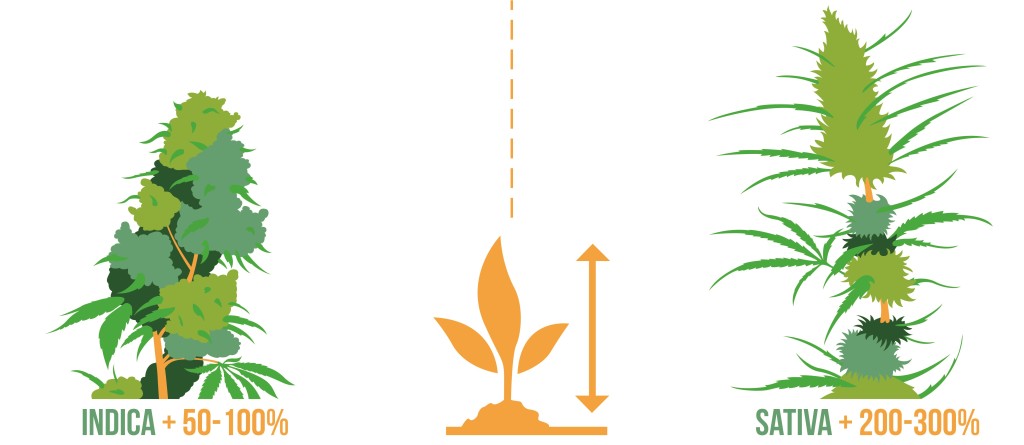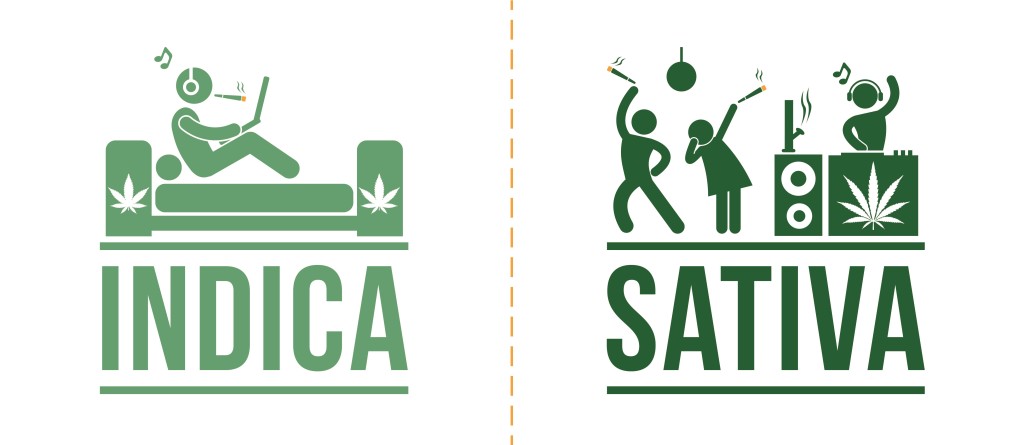What is the difference between indica and sativa?
What is the difference between indica and sativa?
This article describes the differences between sativa and indica cannabis plants. Read on to learn more about the origins of sativa and indica, as well as how they differ in growth patterns, appearance, and the effects they produce when consumed.
The two most well-known types of cannabis plants are indica and sativa. The differences between indica-dominant cannabis strains and sativa-dominant cannabis strains are many and varied.
Indica strains have a different spectrum of effects on the body and mind than Sativa strains. Both have different medical benefits.
The Indica strain is commonly associated with a feeling of deep relaxation in the body. Sativa varieties tend to provide a more energetic experience.
Scientifically (and legally) there is no difference between Indica and Sativa cannabis plants. And all cannabis plants are considered Cannabis Sativa L..
There are many different growth patterns, qualities and effects on the cannabis spectrum.
The differences between indica and sativa have a lot to do with the fact that cannabis shows a remarkable ability to adapt to a wide range of different conditions.
Because all branches of the cannabis family tree can interbreed freely (including industrial hemp and Cannabis ruderalis J.), some botanists consider all forms of the plant to be members of the same polymorphic species.
Indica vs Sativa
Most indica varieties come from Central Asia and the Indian subcontinent - Afghanistan, Pakistan, northern India, Tibet, Nepal and so on.
Sativa usually come from the equatorial regions - Thailand, southern India, Jamaica, Mexico and so on.
The difference in appearance between Sativa and Indica
Indica is compact and stocky, with dense, heavy, fragrant buds.
Cannabis plants form nodes at regular intervals along their stems, and these nodes are the places where leaves, branches and flowers (buds) form. Indica buds tend to grow in tight clusters around stem and branch nodes with relatively short spaces (known as internodal spacing) between each cluster.
Under the same conditions, sativas grow taller than indicas.
Sativa buds tend to grow larger than Indica buds, as they run the length of the branch rather than clustering around nodes. However, when dry, they usually weigh less than indica due to their lower density.
Sativa buds also have a less pronounced smell, both during growth and when dry.
Bloom Time - Indica vs Sativa!
Indica's are faster-flowering strains that typically bloom for 45 to 60 days.
The main difference between indica and sativa is that sativa takes longer to flower, 60 to 90 days to finish flowering.
However, they require less time for vegetative growth before flowering than indicas, so the total time needed for a sativa is about the same as for an indica (and sometimes less in terms of "light hours").

Size difference between indica and sativa
Indica plants gain height fairly quickly once they start flowering, but under normal conditions, they shouldn't get out of control.
An indica can be expected to increase its vegetative height by 50-100% during the flowering period.
In tropical regions, days tend to be relatively short - around 12 hours throughout the year - so sativas are adapted to grow and flower at the same time, instead of having separate vegetative and flowering stages like indicas.
With a 12/12 indoor flowering cycle, sativas will grow and bloom at the same time as they would in their natural environment.
Sativa plants can grow in height very quickly after they start flowering and often continue to grow in height throughout the flowering phase.
It is normal for sativas to gain 200-300% (or even more) of their vegetative height when flowering.

The difference in effect - indica vs sativa
Perhaps the most profound but most difficult to describe difference between indica and sativa strains lies in their effect. This can be especially difficult for people who have never used psychoactive substances to understand. In addition, new data suggests that the reason for the differences is not what we always thought!
There are various posts on this blog about the physical, historical, or geographic differences between the two main types of our favorite plant, but this article focuses on the differences between the effects of indica and sativa varieties. (For simplicity, we will assume that "indica" means "indica-dominant" and sativa means "sativa-dominant" in this context.)
Typical indica effects
The Indica cannabis variety is associated with a feeling of relaxation in the body, as if stress is being removed from the muscles. If you're feeling tense or feel like you're overwhelmed by pressure, drinking indica can take that discomfort away and replace it with a sleepy ease. Imagine yourself soaking in a warm bath or relaxing after a good massage.
Thoughts slow down, time seems to slow down and, in classic Stoner fashion, you may become so relaxed that you forget what you were doing or were going to do! An often cited difference between the effects of indica and sativa is that indica produces feelings of drowsiness and inactivity, while sativa causes a desire to be active.
Typical Sativa Effects
Sativa strains are associated with an uplifting feeling in the head and mind. Creativity can begin to flow to the point where you suddenly become aware that you are staring into space as idea after idea races through your mind and concepts that previously seemed unrelated come together to create new inspiration. There are numerous anecdotal reports and even some scientific data on the tendency of cannabis to improve pattern recognition. There is no research on whether sativas produce this effect more than indicas, but it may well be the case.
You may also find things funny or much funnier than usual. Sativa can make you helpless with laughter, suddenly gifted with a new appreciation for the absurd. You may be seized by an energetic desire to do something; what this "something" is depends largely on the person. Athletes can go for a run or work out. Artists can create, musicians can play music, gardeners can garden, and so on. The inspiration bestowed by the sativa effect will manifest itself in whatever comes to hand.
How it all began!
Cannabis sativa L. was first classified in 1753 CE; Cannabis Indica Lam. in 1785 AD These classifications were not based on effect, but on botany. Modern cannabis writers such as Robert Connell Clark drew on these classifications in their early work. They have added more information on the type of high or stone you can get from sativa and indica.
Research into the effects of cannabis led to the discovery and then synthesis of CBD in 1963 and THC in 1964. For decades, cannabis sativa strains were thought to contain higher levels of THC, while indica cannabis strains were thought to contain higher levels of CBD. The restrictions of the ban meant that this information was mostly spread by word of mouth, but spread.
All of the information about the various sativa and indica effects described above has been "known" since at least the 1970s, when ad hoc breeding schemes and access to genetics from all over the world came together. Ben Dronkers and his contemporaries were instrumental in honing and refining wild landrace varieties into the building blocks of the modern cannabis seed industry – indica, sativa and hybrids.
The abundance of cannabis hybrids is growing exponentially year by year, with research in cannabis chemistry and taxonomy barely keeping up. Although people have known about the psychoactive effects of cannabis for millennia, we have only learned why - the existence of the endocannabinoid system - since the late 1980s.
Objective cannabis science is still in its infancy. Compared to the subjective experience of millions of cannabis users, it is practically still in its infancy. Where does all this lead? The discovery that there is little to no difference between sativa and indica in CBD and THC levels.
With the publication of Cannabis: Evolution and Ethnobotany in 2013, the commonly used definitions of indica and sativa (despite being based on the work of Linnaeus and Lamarck) have been questioned both for their accuracy and their usefulness.
Instead, the terms "broadleaf cannabis/drug" and "narrowleaf cannabis/drug" have been proposed to more accurately describe the four main types of cannabis rather than two. In practice, this has not yet caught on.
Over the past two years, studies have been published based on science, not anecdotal evidence, that contradict everything we thought we knew about the difference not only between emergence and evolution, but also the effects of indica and sativa.
Dr. Ethan Russo is a neuroscientist, psychopharmacology researcher, and medical director of PHYTECS, a biotechnology company that researches the human endocannabinoid system. In this compelling 2016 interview, he's open about his assessment of the current popular understanding of the differences between indica and sativa effects:
"... The sativa/indica distinction commonly used in the lay literature is complete nonsense and a useless exercise... the biochemical components of a given cannabis strain need to be quantified and compared with observed effects in real patients."
Dr. Rousseau goes on to say that monoterpenes are behind the different effects of different types of cannabis. The sedative effect associated with indica strains and their supposed high CBD and low THC content is due to myrcene. The uplifting feeling we associate with supposedly high THC and low CBD is due to limonene (also found in citrus peels).
Dr. Ryan Vandry, a behavioral pharmacologist at Johns Hopkins University who specializes in cannabis and cannabinoids, disagrees with Dr. Russo's assessment, citing the limited scientific evidence on the topic. This article reviews the various scientific perspectives and available research on the subject in 2016, while this 2018 article adds more details about terpenes.
Full Biochemical Fingerprint Mapping
If you want to really dive into the science, "Cannabis: From Variety to Chemovar II - A Metabolic Approach to Cannabis Classification" from 2016 seems to be the most in-depth study so far. It postulates that the use of chemovar mapping—creating a sort of complete biochemical "fingerprint" for each strain based on its cannabinoid, monoterpene, and sesquiterpene profiles—is the best way to determine nomenclature.
This study also has a finding that offers some hope for maintaining the simple, familiar differences between sativa and indica. “…the vernacular Sativa and Indica samples can be divided into two separate groups, which means that there seem to be real differences in chemical composition between these two types of cannabis.”
Instead of basing these classifications on the THC:CBD ratio, other cannabinoids and terpenes are used. The lesser known cannabinoids cannabichromene (CBC) and cannabigerol (CBG) were found to be "slightly but significantly higher" in strains named sativas. For "identifying (folk) types of Indica [sic]", the different terpene composition and the presence of hydroxylated terpenes are described as "good chemical markers".
We are just diving into the deep science of cannabis
This corresponds not only to scientific, but also to unconfirmed data. Experience tells us irrefutably that different types of cannabis produce different effects; the only problem is that we thought we knew why, but we're just starting to scratch the surface of the topic.
You can think of it as the evolution of planetary science. People have always seen the sun moving across the sky. Theories as to why this happens have evolved from the fact that the Earth is flat and the Sun is in a moving dome above it, then the Sun orbits the spherical Earth, then the spherical Earth orbits the Sun in one tiny galaxy out of a potential number of two trillion galaxies.
Despite the fact that we learned about it, the sun continued to travel through the sky in the same way; despite what we learn about cannabis, different types of cannabis will still have different effects on us.









